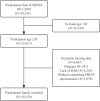Association between red blood cell distribution width-to-albumin ratio and depression: a cross-sectional analysis among US adults, 2011-2018
- PMID: 40335911
- PMCID: PMC12060335
- DOI: 10.1186/s12888-025-06907-z
Association between red blood cell distribution width-to-albumin ratio and depression: a cross-sectional analysis among US adults, 2011-2018
Abstract
Background: Red blood cell distribution width (RDW)-to-albumin ratio (RAR) is a novel index. Its relationship with depression, a common and complex psychiatric disorder, remains unclear. This study utilized the National Health and Nutrition Examination Survey (NHANES) database to investigate this relationship.
Methods: Multivariate logistic regression, restricted cubic spline (RCS) regression, receiver operating characteristic (ROC) analysis, and sensitivity analyses were used to examine the relationship between RAR and depression based on NHANES data from 2011-2018. The study also used subgroup analyses and interaction tests to explore whether the relationship was stable across populations.
Results: RAR was positively associated with depression in 18,150 participants aged ≥ 20 years. In fully adjusted models, each one-unit increase in RAR was associated with a 22% increase in the likelihood of depression [1.22 (1.05, 1.41)]. Participants in the highest quartile of RAR had a 30% higher risk of depression than those in the lowest quartile of RAR [1.30 (1.04, 1.63)]. Subgroup analyses revealed that the association between RAR and depression was significantly stronger among men, alcohol-drinking and high-income groups.
Conclusions: Higher baseline RAR was associated with an increased risk of depression in US adults and was more informative than RDW, albumin, and hemoglobin-to-RDW ratio (HRR). Further large-scale prospective studies are needed to analyze the role of RAR in depression. These findings emphasize that RAR can be a simple, reliable and cost-effective predictor of depression in clinical practice.
Keywords: Cross-sectional study; Depression; NHANES; RAR.
© 2025. The Author(s).
Conflict of interest statement
Declarations. Ethics approval and consent to participate: The protocols of NHANES were approved by the institutional review board of the National Center for Health Statistics, CDC ( https://www.cdc.gov/nchs/nhanes/irba98.htm ). NHANES has obtained written informed consent from all participants before enrolment. Consent for publication: Not applicable. Competing interests: The authors declare no competing interests.
Figures



Similar articles
-
The association between red blood cell distribution width-to-albumin ratio and risk of depression: A cross-sectional analysis of NHANES.J Affect Disord. 2025 Jun 15;379:250-257. doi: 10.1016/j.jad.2025.03.037. Epub 2025 Mar 12. J Affect Disord. 2025. PMID: 40086477
-
Ratio of Red Blood Cell Distribution Width to Albumin Level and Risk of Mortality.JAMA Netw Open. 2024 May 1;7(5):e2413213. doi: 10.1001/jamanetworkopen.2024.13213. JAMA Netw Open. 2024. PMID: 38805227 Free PMC article.
-
Association of Red Blood Cell Distribution Width to Albumin Ratio With the Prevalence of Kidney Stones Among the General Adult Population.Immun Inflamm Dis. 2024 Nov;12(11):e70070. doi: 10.1002/iid3.70070. Immun Inflamm Dis. 2024. PMID: 39570091 Free PMC article.
-
Association between red cell distribution width/serum albumin ratio and Parkinson's disease.Eur J Med Res. 2025 May 31;30(1):431. doi: 10.1186/s40001-025-02707-z. Eur J Med Res. 2025. PMID: 40448230 Free PMC article.
-
Red blood cell distribution width to albumin ratio (RAR) is associated with low cognitive performance in American older adults: NHANES 2011-2014.BMC Geriatr. 2025 Mar 7;25(1):157. doi: 10.1186/s12877-025-05800-4. BMC Geriatr. 2025. PMID: 40055657 Free PMC article.
Cited by
-
The Red Blood Cell Distribution Width-to-Albumin Ratio's Role in Parkinson's Disease: A Cross-Sectional Study.J Clin Med. 2025 Jul 10;14(14):4908. doi: 10.3390/jcm14144908. J Clin Med. 2025. PMID: 40725602 Free PMC article.
References
-
- Chen MH, Pan TL, Bai YM, Huang KL, Tsai SJ, Su TP, et al. Postpartum depression and psychosis and subsequent severe mental illnesses in mothers and neurodevelopmental disorders in children: a nationwide study. J Clin Psychiatry. 2021;82:20m13735. - PubMed
-
- Smith K. Mental health: a world of depression. Nature. 2014;515:181. - PubMed
-
- Yang C-H, Lv J-J, Kong X-M, Chu F, Li Z-B, Lu W, et al. Global, regional and national burdens of depression in adolescents and young adults aged 10–24 years, from 1990 to 2019: findings from the 2019 Global Burden of Disease study. Br J Psychiatry J Ment Sci. 2024;225:311–20. - PubMed
MeSH terms
Substances
Grants and funding
LinkOut - more resources
Full Text Sources
Medical

